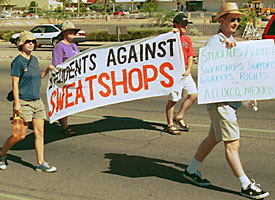 |
|
file photo/Arizona Daily Wildcat
|
Students Against Sweatshops was one of many organizations to march at the Reid Park Labor Day Parade, Sept. 4th. Participants shouted slogans and marched to show support for their organizations.
|
|
By Sarah Nixon
Arizona Daily Wildcat
Tuesday December 3, 2002
The group that locked down the Administration building two years ago and held regular protests on the UA Mall to call attention to workers' rights has been quieted by a loss of members, a scattered agenda and fewer planning meetings.
Students Against Sweatshops conducts more business online, does not hold regular meetings and has lost members who have graduated, said SAS member Rachel Wilson.
The highly-visible student group became well known in recent years for protesting around campus in the hopes of persuading administrators to sever the university's ties with factories the group says are sweatshops.
SAS currently has about 10 active members and is meeting irregularly, Wilson said.
That's down from 30 active members two years ago, said Wilson, who recently earned her doctoral degree and is now a researcher on campus.
Last year, when SAS was aggressively protesting UA's membership in the Fair Labor Association, the group also had roughly 10 active members, said classics masters student and SAS member Mark Rivera.
The group does not have a president or treasurer and is not recognized by student government as a club, because they did not apply for recognition.
Protests and research used to be planned during Thursday meetings, but now research and comments are made online.
"Membership is a little bit low right now, but one reason for that is that we don't have regular meetings," Wilson said.
The club has met sporadically this year.
The group has also suffered because too many issues were being protested at once, leaving SAS's agenda scattered and not as effective, Wilson said.
The group would get notice of workers rights violations, one after another, and sometimes there was too much to protest, she said.
Internal strife may also have contributed to the club's low profile this semester.
Female members of SAS went on strike in April to protest being given a disproportionate amount of the club's work, Rivera said.
"We've been working to deal with of those issues this semester," he said.
Though SAS didn't accomplish its primary goal on campus ÷ getting UA to leave the Fair Labor Association worker's rights monitory group for the Workers' Rights Consortium ÷ members of the group have not given up on the clothing campaign.
"It has been a while since we've had communication with administration, which is something we've been discussing," Rivera said.
SAS protested the UA's membership in the FLA, a non-profit organization made up of 176 universities and colleges that aims to improve working conditions worldwide. The FLA does not take a strong enough stance in favor of workers' rights, SAS members have long held.
UA is also a member of the competing Worker Rights Consortium, a non-profit organization comprised of 109 colleges and universities and designed to ensure that factories producing clothing that bears university logos respect workers' rights.
UA has no future plans of revoking it's FLA membership, though, budget cuts may cause UA administrators to take a closer look on what expenditures can be sacrificed, said Michael Low, director of trademark licensing.
It is definitely positive for UA to be a member of FLA, as well as WRC, said Michael Low, director of trademark licensing. Both organizations perform positive investigations from different viewpoints, Low said.
"Paying dues to both FLA and WRC seems to be a waste of money," Rivera said.
The UA sends about 1 percent of revenues generated from the sale of licensing rights to the FLA. SAS's current long-term project is trying to persuade administrators to allow a Douglas-based worker-owned business to buy the right to produce merchandise bearing the UA logo at a reduced rate, Wilson said.
SAS members met Nov. 24 to discuss plans and new campaigns for next semester.
Though she would not give specifics at this point, the group is also planning to examine UA's funding "mechanisms" next semester, Wilson said.

